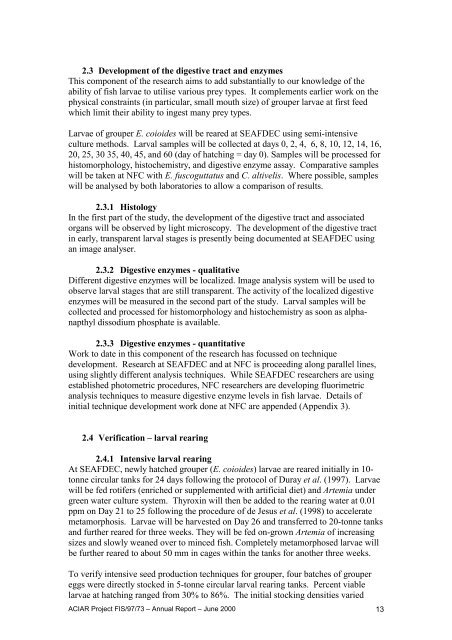ACIAR Project FIS/97/73 - Library - Network of Aquaculture Centres ...
ACIAR Project FIS/97/73 - Library - Network of Aquaculture Centres ...
ACIAR Project FIS/97/73 - Library - Network of Aquaculture Centres ...
Create successful ePaper yourself
Turn your PDF publications into a flip-book with our unique Google optimized e-Paper software.
2.3 Development <strong>of</strong> the digestive tract and enzymesThis component <strong>of</strong> the research aims to add substantially to our knowledge <strong>of</strong> theability <strong>of</strong> fish larvae to utilise various prey types. It complements earlier work on thephysical constraints (in particular, small mouth size) <strong>of</strong> grouper larvae at first feedwhich limit their ability to ingest many prey types.Larvae <strong>of</strong> grouper E. coioides will be reared at SEAFDEC using semi-intensiveculture methods. Larval samples will be collected at days 0, 2, 4, 6, 8, 10, 12, 14, 16,20, 25, 30 35, 40, 45, and 60 (day <strong>of</strong> hatching = day 0). Samples will be processed forhistomorphology, histochemistry, and digestive enzyme assay. Comparative sampleswill be taken at NFC with E. fuscoguttatus and C. altivelis. Where possible, sampleswill be analysed by both laboratories to allow a comparison <strong>of</strong> results.2.3.1 HistologyIn the first part <strong>of</strong> the study, the development <strong>of</strong> the digestive tract and associatedorgans will be observed by light microscopy. The development <strong>of</strong> the digestive tractin early, transparent larval stages is presently being documented at SEAFDEC usingan image analyser.2.3.2 Digestive enzymes - qualitativeDifferent digestive enzymes will be localized. Image analysis system will be used toobserve larval stages that are still transparent. The activity <strong>of</strong> the localized digestiveenzymes will be measured in the second part <strong>of</strong> the study. Larval samples will becollected and processed for histomorphology and histochemistry as soon as alphanapthyldissodium phosphate is available.2.3.3 Digestive enzymes - quantitativeWork to date in this component <strong>of</strong> the research has focussed on techniquedevelopment. Research at SEAFDEC and at NFC is proceeding along parallel lines,using slightly different analysis techniques. While SEAFDEC researchers are usingestablished photometric procedures, NFC researchers are developing fluorimetricanalysis techniques to measure digestive enzyme levels in fish larvae. Details <strong>of</strong>initial technique development work done at NFC are appended (Appendix 3).2.4 Verification – larval rearing2.4.1 Intensive larval rearingAt SEAFDEC, newly hatched grouper (E. coioides) larvae are reared initially in 10-tonne circular tanks for 24 days following the protocol <strong>of</strong> Duray et al. (19<strong>97</strong>). Larvaewill be fed rotifers (enriched or supplemented with artificial diet) and Artemia undergreen water culture system. Thyroxin will then be added to the rearing water at 0.01ppm on Day 21 to 25 following the procedure <strong>of</strong> de Jesus et al. (1998) to acceleratemetamorphosis. Larvae will be harvested on Day 26 and transferred to 20-tonne tanksand further reared for three weeks. They will be fed on-grown Artemia <strong>of</strong> increasingsizes and slowly weaned over to minced fish. Completely metamorphosed larvae willbe further reared to about 50 mm in cages within the tanks for another three weeks.To verify intensive seed production techniques for grouper, four batches <strong>of</strong> groupereggs were directly stocked in 5-tonne circular larval rearing tanks. Percent viablelarvae at hatching ranged from 30% to 86%. The initial stocking densities varied<strong>ACIAR</strong> <strong>Project</strong> <strong>FIS</strong>/<strong>97</strong>/<strong>73</strong> – Annual Report – June 2000 13
















